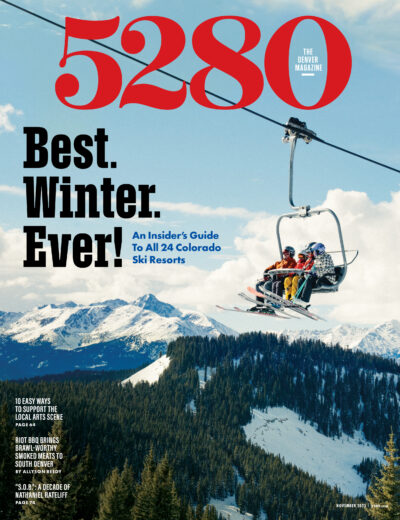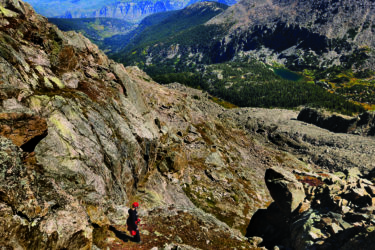The Local newsletter is your free, daily guide to life in Colorado. For locals, by locals.
Samuel Massman has the same feeling a lot of his neighbors have: It’s getting crowded out there. A longtime Summit County resident, Massman serves as the forest recreation program manager for White River National Forest, which encompasses Maroon Bells, Hanging Lake, and 11 ski areas. Considering that wealth of natural riches, it’s no surprise White River is the country’s busiest national forest. In 2022, it saw about 18.4 million visits, up from 12.3 million in 2013.
Massman often hears locals around Frisco swapping reports about where to find peace and quiet. They’re right to rely on such anecdotal evidence, because federal data is short on details. Both the U.S. Forest Service (USFS) and the U.S. Bureau of Land Management (BLM) extrapolate physical visitor counts—taken either by hand or with infrared trail monitors—to help determine the number of people who visit their public lands each year. Permits sold, campsite reservations, and ski area ticket sales help complete the big picture. State and national parks, meanwhile, estimate visitation largely by counting the number of vehicles that roll through their entrance gates. The approaches are so wildly different that figures between agencies can’t really be compared, but both methods share the same problem: Neither count can accurately say where visitors go once they’re inside.
Outdoor recreation has exploded in recent years, jumping from an industry worth $8 billion to one valued at $17 billion in Colorado over the past decade. Without statistics about exactly which trails and campsites are seeing the most traffic, though, land managers don’t have all the information they need to best serve the millions of hikers, campers, bikers, skiers, and off-highway vehicle (OHV) riders who visit each year. “We have a sense of where people are going and what they’re doing, just from being here,” Massman says, “but what we don’t have is data.”
Fortunately for outdoors enthusiasts, big data is also enjoying a boom. People record and share where they go in the woods, often with GPS information embedded in everything from photos to workouts. Plus, mobile phones are constantly logging locations, even in the backcountry. The questions now are if and how these technology-based solutions can fill in some of the outdoor industry’s blanks. But getting everyone on the same page—or app, as it were—won’t be easy.
Trails packed body-to-body, parked vehicles blocking snowplow turnarounds, proliferating piles of human and pet poop: These are just a few of the things that convinced the Colorado Mountain Club (CMC) it was time to start quantifying just how bad things were getting in the backcountry. In 2019, the Golden-based education, stewardship, and conservation nonprofit launched the Recreation Impact Monitoring System (RIMS), an app that equips everyday hikers to do the kind of daily monitoring that land managers often can’t.
Vetted users tally vehicles at parking lots, noting which states the plates are from and whether they’re towing snowmobile or OHV trailers. They can also report problems like washed-out creek crossings, trees that have fallen over trails, or trash cans mauled by bears. The collected data feeds into a web portal that land managers can pay to access.
This past summer, two CMC surveyors spent 12 weeks backpacking through thick spruce and fir forests and elk-spotted alpine meadows in southwestern Colorado’s La Garita Wilderness. They checked wilderness campsites—particularly noting whether they were expanding, shrinking, or remaining stable. They also determined the most likely locations for future campsites and even reported illegal activity. “Getting volunteers out there to collect this data should be imperative, because we know the Forest Service can’t do it,” says Brian Bergeler, stewardship manager for the nonprofit. “And we know if we push that data to them, they can use it for constructive purposes”—for example, shuttering rogue campsites or deciding whether to launch a permit system.
RIMS faces a few hurdles, recruiting volunteers among them. Also, some land managers already have their own programs: The Grand Mesa, Uncompahgre, and Gunnison National Forest only used RIMS to inventory campsites in La Garita because the CMC secured a grant from the National Wilderness Stewardship Alliance to fund the project. Otherwise, says Joseph Carlson, wilderness manager for the Gunnison Ranger District, he uses a similar app called Survey123, made by a California software developer.
The dueling apps highlight a key obstacle to finding real answers: Plenty of technologies exist, but none are perfect or comprehensive. Megan Lawson, who studies outdoor recreation for Headwaters Economics, a national nonprofit based in Bozeman, Montana, paired trail monitors—infrared beams that count passing bodies—and workouts tracked using the fitness app Strava to identify the most popular loops in a spaghetti’d trail system in Montana. But Strava represents just one to five percent of total trail users, according to Lawson’s research, which also looked at social media and photo-sharing apps, like Instagram, X, and Flickr, in addition to Google search trends. Social media mostly catches tourists’ posts, leaving out locals’ routine visits. Flickr users tend to be female and younger. “They all have different strengths and weaknesses,” Lawson says. “There is no single source that captures it all.”
What looks to be the most accurate option for getting head counts on the trails is also the most invasive. Any number of apps with pop-ups asking for consent to share location information—including weather, fitness, news, and even game apps like Pokémon GO—track and sell users’ whereabouts. Rocky Mountain National Park used cell phone information to create a timed-entry system for its busiest hours and months. Colorado Parks and Wildlife is investigating using anonymized phone data to provide information about how busy trails are. And White River, through a partnership with Colorado State University, is looking at whether location records can answer some of the questions it has. The future could see a statewide version of a mobile phone data dashboard, like the one created by NoCo Places, a collaborative of nine county, state, and federal land management agencies in the northern Front Range that used a snapshot of phone locations to chart the busiest trailheads.
As promising as cell phone location information may seem, it’s not without concerns. For example, the technology doesn’t show how many people hike a trail in a year, says Steve Coffin, executive director of NoCo Places; instead, it provides a point-in-time record that can be used to identify patterns. And major cell service providers haven’t exactly been transparent about who benefits from location tracking. In April 2024, the Federal Communications Commission fined AT&T, Sprint, T-Mobile, and Verizon nearly $200 million for illegally sharing access to customers’ location data. Other parties, like lawmakers arguing for stiffer regulations, contend it’s unclear to consumers that consenting to local news and weather updates means consenting to the sale of their whereabouts—down to a few yards.
“Your phone is always tracking you,” says John Hannon, project manager for NoCo Places—even if your device doesn’t have enough of a signal to send a text. “Trail runners are always in places where there’s no service, but you can get a great map of where they’ve been.”
In 2022, White River brought in Forest Service statisticians to tease out some of its busiest locations. What they discovered was troubling: Not counting ski resorts, about 60 percent of visitors squeeze onto 20 percent of sites within the 2.3-million-acre forest—and those spots aren’t necessarily the best-prepared places to host the hordes. “We have some trailheads that have 60,000-, 70,000-plus visits a year, and we don’t have a designed parking lot,” Massman says. “It’s just a wide spot in the road.” Many of the most popular sites don’t even have bathrooms.
Those visitors will have to go without for the foreseeable future. “As visitation has increased across the forest incredibly over time, we have not had the ability to build facilities to keep up,” Massman says. That’s in part because the share of the USFS’ and the BLM’s budgets dedicated to recreation has not grown at the same pace as their crowds. At White River, the budget has actually gone down.
Federal agencies and the politicians who fund them are still recalibrating. In the past, oil and gas and timber companies paid royalties and fees to take natural resources from USFS and BLM land. The revenue not only offset expenses on public lands, but it also funneled profits to state and federal governments. As recreation has become public lands’ main economic driver, however, lawmakers have been reluctant to invest in that economic engine. “We think a big part of that is because they don’t have good numbers to justify increasing their funding,” says Headwaters’ Lawson.
The data that does exist favors specific recreationists, such as hunters and anglers, who pay for licenses and, thus, directly fund conservation. As a result, wildlife biologists manage public lands to benefit those groups—sometimes at the expense of, say, backcountry skiers, who usually slide onto the slopes unnoticed. Often, the same goes for hikers. Lawson has spoken with land managers trying to account for these visitors by counting rolls of toilet paper or dog bags used. “We’re hearing these stories and going, ‘There has to be a better way,’ ” she says.
Thanks to apps like RIMS, there is—but no single technology has yet united all public lands. “I would love to see one single source of truth for public lands GIS, mapping, and visitor use data,” says Pitt Grewe, AllTrails’ head of public lands partnerships. “It would be a key unlock for both private and public partnerships that support recreation on our public lands.”
Read More: What the New EXPLORE Act Will Mean for Coloradans
Due to new legislation, someone will have to figure it out: In December, Congress passed the EXPLORE Act, a bundle of outdoor-focused legislation that directs all federal land managers to create a single visitation-data-reporting system for more accurate annual counts. The act also mandates that federal land management agencies create a pilot project in the next two years for publishing real-time or predictive data on which places are busiest. It’s up to each branch to decide which course of action they’ll take. The mandates may compel agencies to look to tech companies and app developers for a new universal solution, says Mike Leonard, vice president of government affairs for the American Sportfishing Association, which lobbied for the legislation. “If the private sector is already collecting all this information, it’s just a matter of pulling it together,” Leonard says. “Now they have the authority and the motivation to make sure it happens.”
It could be a while before the numbers from a new reporting system begin informing budgets at cash-strapped federal agencies. In the meantime, the data may alleviate pressure simply by alerting visitors about traffic jams on public lands. During a recent visit to Utah’s Arches National Park, Jessica Wahl Turner, president of the Outdoor Recreation Roundtable, an industry advocacy group, squeezed onto the trail to the Delicate Arch overlook with what she says felt like a thousand other people. She wishes she’d known about other paths in the park, or that nearby Canyonlands National Park also boasts an abundance of arches and half as many people, or that the view from an adjacent state park is every bit as good.
“We always talk about ‘loving things to death’ and ‘overcrowded,’ and those words are not informed, right? They’re just a feeling, or a sense,” she says. “Not the entire park of Arches is overcrowded. There are places that have probably not seen a person in years and don’t have a single footprint. I think we’ve just got to be more sophisticated.” In other words, like Massman in White River, Wahl Turner needs numbers, not just notions.









